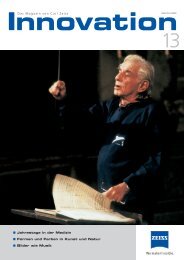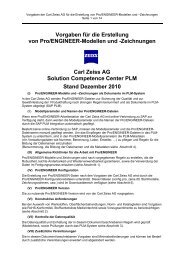Download PDF - Carl Zeiss
Download PDF - Carl Zeiss
Download PDF - Carl Zeiss
You also want an ePaper? Increase the reach of your titles
YUMPU automatically turns print PDFs into web optimized ePapers that Google loves.
Highlights from the History of Immersion<br />
details<br />
16<br />
Immersion oil<br />
In the beginning, natural cedar<br />
oil was used. Gradual thickening<br />
leads to alteration of the<br />
refractive index over time.<br />
Exposed to air, it turns to resin<br />
and becomes solid.<br />
Nowadays, synthetic immersion<br />
oil with a constant refractive<br />
index is used. It does not harden<br />
in air and can therefore be<br />
stored longer.<br />
Robert Hooke (1635-1703) was the<br />
first to discuss the technique of<br />
immersion: “that if you would have a<br />
microscope with one single refraction,<br />
and consequently capable of<br />
the greatest clearness and brightness,<br />
spread a little of the fluid to be examined<br />
on a glass plate, bring this<br />
under one of the globules, and then<br />
move it gently upward till the fluid<br />
touches and adheres to the globule.”<br />
His “Lectures and Collections” from<br />
1678, published in his book “Microscopium”<br />
in the same year, thus<br />
marked the beginning of oil immersion<br />
objectives.<br />
Sir David Brewster (1781-1868)<br />
proposed the immersion of the objective<br />
in 1812. Around 1840, Giovanni<br />
Battista Amici (1786-1868) produced<br />
the first immersion objectives<br />
that were used with anis oil and had<br />
the same refractive index as glass.<br />
However, this type of immersion was<br />
not yet used to increase the aperture,<br />
but more to correct chromatic aberration.<br />
Amici had already recognized<br />
this problem during Brewster’s time.<br />
Because microscope slides were very<br />
expensive at the time, microscopists<br />
in the 19th century did not yet accept<br />
oil immersion. Amici gave up on oil<br />
immersion and converted to water<br />
immersion. A short time later in<br />
1853, he built the first water immersion<br />
objective and presented it in<br />
Paris in 1855.<br />
In 1858, Robert Tolles (1822-<br />
1883) built his first water immersion<br />
objective which had two exchangeable<br />
front lenses: one for working<br />
under dry conditions, the other for<br />
water immersion.<br />
Approximately 15 years later in<br />
1873, he constructed his famous<br />
1/10 objective for homogenous immersion.<br />
Edmund Hartnack (1826-<br />
1891), who in 1859 presented his<br />
first water immersion objective, also<br />
added a correction ring for the first<br />
time. Hartnack sold around 400<br />
models over the next five years. By<br />
1860, many German microscope<br />
manufacturers offered water immer-<br />
Innovation 15, <strong>Carl</strong> <strong>Zeiss</strong> AG, 2005
















